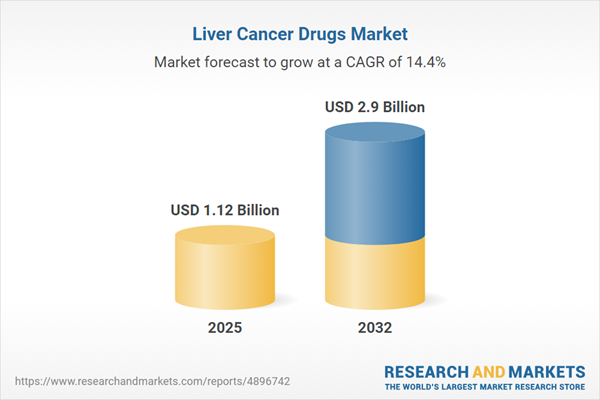Speak directly to the analyst to clarify any post sales queries you may have.
The global liver cancer drugs market is undergoing significant transformation, driven by advancements in therapeutics, evolving healthcare delivery, and changing strategies among key industry participants. Decision-makers seeking growth must stay ahead of market movements to refine competitive positioning and ensure future-ready planning.
Market Snapshot: Liver Cancer Drugs Market
As of 2024, the liver cancer drugs market is valued at USD 987.60 million and is projected to reach USD 1.12 billion in 2025, with a compound annual growth rate of 14.44%. The market is expected to exceed USD 2.90 billion by 2032. Expansion is propelled by continuous oncology innovation, wider treatment access, and increased global investment across research and commercialization efforts. This trajectory highlights a sector where development speed and global demand are redefining business priorities.
Scope & Segmentation Analysis
This research report provides deep, actionable insight into the liver cancer drugs market, analyzing trends across product types, modalities, and clinical adoption worldwide. Leaders can leverage segment performance and emerging areas of demand to sharpen commercialization plans and prioritize strategic investments.
- Therapy Types: Includes chemotherapy, targeted therapy, immunotherapy, and radiation therapy, each advancing new care standards and expanding innovation pipelines.
- Cancer Types: Focus on cholangiocarcinoma, hepatoblastoma, and hepatocellular carcinoma, allowing companies to address distinct clinical and development challenges for these subtypes.
- Administration Routes: Captures intravenous, oral, and subcutaneous delivery, reflecting the growing influence of patient preferences and supporting flexible care models outside hospital environments.
- Drug Classes: Covers cytotoxic agents, monoclonal antibodies, and tyrosine kinase inhibitors, illustrating the transition from established treatments toward targeted molecular and immune-based options.
- End Users: Examines home care, hospitals, and specialty clinics as principal settings, each shaping adoption trends, treatment pathways, and engagement strategies.
- Distribution Channels: Assesses hospital pharmacies, online pharmacies, and retail pharmacies, highlighting digital transformation and shifts in how therapies are accessed.
- Regional Coverage: Encompasses Americas, Europe, Middle East & Africa, and Asia-Pacific, each presenting unique regulatory scenarios, payer frameworks, and market access requirements.
- Key Companies Profiled: Bayer AG, Eisai Co., Ltd., Bristol-Myers Squibb Company, Merck & Co., Inc., F. Hoffmann-La Roche Ltd, Ipsen S.A., AstraZeneca plc, Exelixis, Inc.
Detailed segmentation equips executives with the clarity to align product strategy with evolving clinical demands, anticipate patient shifts, and respond to technological and regulatory change.
Liver Cancer Drugs Market: Key Takeaways
- There is a clear movement from traditional therapies to precision-based treatment, with molecular and immuno-oncology agents increasingly prominent in clinical adoption strategies.
- Precision biomarker profiling and immune checkpoint inhibitor use are improving patient targeting, driving more durable responses and expanding treatment success in challenging cases.
- Growth in oral and subcutaneous formulations is accelerating out-of-hospital delivery models and supporting a patient-centric care philosophy.
- Emerging technologies such as oncolytic viruses and adoptive cell therapies are opening highly tailored options for patients previously underserved by conventional treatments.
- Strategic partnerships, cross-border alliances, and investments in manufacturing capabilities are helping market leaders expand access and accelerate regulatory compliance globally.
Tariff Impact on Liver Cancer Pharmaceutical Supply Chains
Recent tariff adjustments in the United States are altering supply chain approaches for liver cancer drugs. Increased costs for critical pharmaceutical components are prompting stakeholders to diversify supplier networks and boost domestic sourcing. Companies are responding with mitigations including increased local inventories, reshoring selected production, and adapting contracts to address tariff-related compliance. These changes are crucial to maintain uninterrupted product flow and meet rigorous oncology standards.
Methodology & Data Sources
This analysis integrates primary interviews with oncologists and industry executives, supplemented by secondary research from peer-reviewed journals, trial registries, and regulatory documents. Expert panel review and advanced analytical tools ensure findings meet the decision-support needs of senior leadership.
Why This Report Matters
- Provides forward-looking insights into evolving therapies, supply chain resilience, and patient-centered business models to inform leadership strategy and partnership selection.
- Enables effective navigation of regulatory change and tariff impacts for streamlined sourcing and operations in the global pharmaceutical market.
- Facilitates benchmarking of commercial and operational initiatives for sustained market advantage in liver cancer drugs.
Conclusion
By leveraging these in-depth market insights, senior executives can anticipate developments, reinforce organizational agility, and drive growth through informed clinical, operational, and regulatory actions.
Additional Product Information:
- Purchase of this report includes 1 year online access with quarterly updates.
- This report can be updated on request. Please contact our Customer Experience team using the Ask a Question widget on our website.
Table of Contents
3. Executive Summary
4. Market Overview
7. Cumulative Impact of Artificial Intelligence 2025
List of Figures
Samples

LOADING...
Companies Mentioned
The key companies profiled in this Liver Cancer Drugs market report include:- Bayer AG
- Eisai Co., Ltd.
- Bristol-Myers Squibb Company
- Merck & Co., Inc.
- F. Hoffmann-La Roche Ltd
- Ipsen S.A.
- AstraZeneca plc
- Exelixis, Inc.
Table Information
| Report Attribute | Details |
|---|---|
| No. of Pages | 180 |
| Published | October 2025 |
| Forecast Period | 2025 - 2032 |
| Estimated Market Value ( USD | $ 1.12 Billion |
| Forecasted Market Value ( USD | $ 2.9 Billion |
| Compound Annual Growth Rate | 14.4% |
| Regions Covered | Global |
| No. of Companies Mentioned | 9 |









